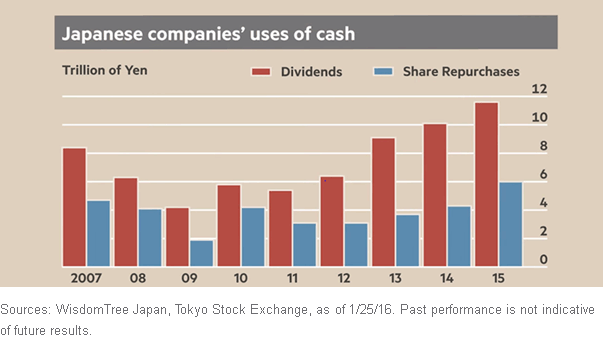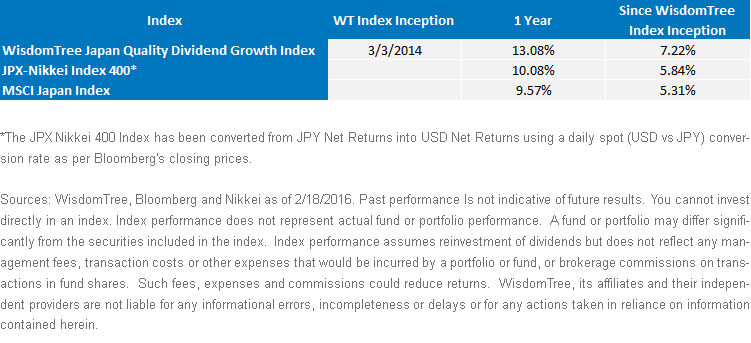What Equity Market Is 30% Cash?


 When companies buy back their stock or pay out dividends to their shareholders, they, in effect, reduce shareholder equity, the denominator in the ROE ratio. This has the effect of increasing the ROE margin for each incremental yen of profit. And with record levels of cash now sitting inside corporate coffers, we believe robust share buybacks and dividend growth are likely to continue in Japan through the remainder of Abe’s term.
Japan Quality Dividend Growth ETFs: Both Yen Hedged or Unhedged
Looking at the performance of the various Japan benchmarks, it is clear the stock selection process underlying WisdomTree’s quality dividend growth strategy has been adding value since WisdomTree started to calculate the WisdomTree Japan Quality Dividend Growth Index in March 2014. Since its inception, this Index has outperformed both the unhedged MSCI Japan Index and the JPX-Nikkei Index 400, a so-called “smart beta” Index that selects companies based on quantitative screens including ROE and operating profits.
Average Annual Total Returns as of 12/31/2015
When companies buy back their stock or pay out dividends to their shareholders, they, in effect, reduce shareholder equity, the denominator in the ROE ratio. This has the effect of increasing the ROE margin for each incremental yen of profit. And with record levels of cash now sitting inside corporate coffers, we believe robust share buybacks and dividend growth are likely to continue in Japan through the remainder of Abe’s term.
Japan Quality Dividend Growth ETFs: Both Yen Hedged or Unhedged
Looking at the performance of the various Japan benchmarks, it is clear the stock selection process underlying WisdomTree’s quality dividend growth strategy has been adding value since WisdomTree started to calculate the WisdomTree Japan Quality Dividend Growth Index in March 2014. Since its inception, this Index has outperformed both the unhedged MSCI Japan Index and the JPX-Nikkei Index 400, a so-called “smart beta” Index that selects companies based on quantitative screens including ROE and operating profits.
Average Annual Total Returns as of 12/31/2015
 Conclusion
For investors interested in tapping into this trend in Japan, WisdomTree recently launched two new exchange-traded-funds (ETFs) that select Japanese companies that have exhibited high ROE and high return on assets (ROA) through a quality growth selection process. WisdomTree weights the stocks in the portfolio annually based on the cash dividends companies have paid in the prior year, in effect rewarding companies that grow their dividends with greater weights. WisdomTree offers hedged and unhedged versions of this strategy. The WisdomTree Japan Quality Dividend Growth Fund (JDG) seeks to provide exposure to higher-quality stocks in Japan that may be positioned to grow their dividends faster than the broader Japanese market. For investors looking to get the same strategy in a currency-hedged format, WisdomTree also offers the WisdomTree Japan Hedged Quality Dividend Growth Fund (JHDG). JHDG owns the same stocks as JDG, but it rolls forward contracts at the end of the each month to mitigate the impact that currency fluctuations in the yen have on the performance of the Fund.
1Sources: WisdomTree Japan, Tokyo Stock Exchange, as of 1/25/16.
Conclusion
For investors interested in tapping into this trend in Japan, WisdomTree recently launched two new exchange-traded-funds (ETFs) that select Japanese companies that have exhibited high ROE and high return on assets (ROA) through a quality growth selection process. WisdomTree weights the stocks in the portfolio annually based on the cash dividends companies have paid in the prior year, in effect rewarding companies that grow their dividends with greater weights. WisdomTree offers hedged and unhedged versions of this strategy. The WisdomTree Japan Quality Dividend Growth Fund (JDG) seeks to provide exposure to higher-quality stocks in Japan that may be positioned to grow their dividends faster than the broader Japanese market. For investors looking to get the same strategy in a currency-hedged format, WisdomTree also offers the WisdomTree Japan Hedged Quality Dividend Growth Fund (JHDG). JHDG owns the same stocks as JDG, but it rolls forward contracts at the end of the each month to mitigate the impact that currency fluctuations in the yen have on the performance of the Fund.
1Sources: WisdomTree Japan, Tokyo Stock Exchange, as of 1/25/16.
Important Risks Related to this Article
There are risks associated with investing, including possible loss of principal. Foreign investing involves special risks, such as risk of loss from currency fluctuation or political or economic uncertainty. Funds focusing their investments on certain sectors may be more vulnerable to any single economic, regulatory or sector-specific development. This may result in greater share price volatility. The Funds focus their investments in Japan, which can be impacted by the events and developments in Japan that can adversely affect performance. Dividends are not guaranteed, and a company currently paying dividends may cease paying dividends at any time.
JHDG uses various strategies to attempt to minimize the impact of changes in the Japanese yen against the U.S. dollar, which may not be successful. Derivative investments can be volatile, and these investments may be less liquid than other securities, and more sensitive to the effects of varied economic conditions. As these Funds can have a high concentration in some issuers, the Funds can be adversely impacted by changes affecting those issuers. The Funds invest in the securities included in, or representative of, their Indexes regardless of their investment merit, and the Funds do not attempt to outperform their Indexes or take defensive positions in declining markets. Due to the investment strategy of the Funds, they may make higher capital gain distributions than other ETFs. Please read each Fund’s prospectus for specific details regarding each Fund’s risk profile.


